Potential Application of Fibers Extracted from Recycled Maple Leaf Waste in Broadband Sound Absorption
Abstract
1. Introduction
2. Material and Sample Preparation
2.1. Extraction Procedures of Maple Leaf Fibers
2.2. Preparation of Sound Absorber Samples with Maple Leaf Fibers
2.3. Microstructure Characterization of Maple Leaf Fibers
2.4. Acoustic Performance Measurement of the Proposed Sound Absorber
3. Result and Discussion
3.1. Microstructure of Maple Leaf Fibers
3.2. Influence of Sample Thickness on the Sound Absorption Coefficient
3.3. Effect of Mass Density Effect on the Sound Absorption Coefficient
3.4. Comparison with Commercial Glass Wool
4. Conclusions
Author Contributions
Funding
Data Availability Statement
Acknowledgments
Conflicts of Interest
References
- Jang, E.S. Sound absorbing properties of selected green material: A review. Forests 2023, 14, 1366. [Google Scholar] [CrossRef]
- Yang, T.; Hu, L.; Xiong, X.; Noman, M.T.; Mishra, R. Sound absorption properties of natural fibers: A review. Sustainability 2020, 12, 8477. [Google Scholar] [CrossRef]
- Halashi, K.; Taban, E.; Soltani, P.; Amininasab, S.; Samaei, E.; Moghadam, D.N.; Khavanin, A. Acoustic and thermal performance of luffa fiber panels for sustainable building applications. Build. Environ. 2024, 247, 111051. [Google Scholar] [CrossRef]
- Othmani, C.; Taktak, M.; Zain, A.; Hantati, T.; Dauchez, N.; Elnady, T.; Fakhfakh, T.; Haddar, M. Acoustic characterization of a porous absorber based on recycled sugarcane wastes. Appl. Acoust. 2017, 120, 90–97. [Google Scholar] [CrossRef]
- Berardi, U.; Iannace, G. Acoustic characterization of natural fibers for sound absorption applications. Build. Environ. 2015, 94, 840–852. [Google Scholar] [CrossRef]
- Glé, P.; Gourdon, E.; Arnaud, L. Acoustical properties of materials made of vegetable particles with several scales of porosity. Appl. Acoust. 2011, 72, 249–259. [Google Scholar] [CrossRef]
- Yuvaraj, L.; Jeyanthi, S.; Yogananda, A. An acoustical investigation of partial perforation in jute fiber composite panel. Mater. Today Proc. 2021, 37, 6. [Google Scholar] [CrossRef]
- Lawanwadeekul, S.; Jun-On, N.; Kongthavorn, P.; Sangkas, T.; Daothong, S. Chemical-free thermal-acoustic panels from agricultural waste for sustainable building materials. Microelectron. J. 2024, 12, 100245. [Google Scholar] [CrossRef]
- Rossi, G. Investigating polylactic acid foam-plant fiber composites for sound absorption and insulation. Sustainability 2024, 16, 6913. [Google Scholar]
- Olcay, H.; Kocak, E.D. Rice plant waste reinforced polyurethane composites for use as the acoustic absorption material. Appl. Acoust. 2020, 173, 107733. [Google Scholar] [CrossRef]
- Khan, A.; Mohamed, M.; Al Halo, N.; Benkreira, H. Acoustical properties of novel sound absorbers made from recycled granulates. Appl. Acoust. 2017, 127, 80–88. [Google Scholar] [CrossRef]
- Arenas, C.; Leiva, C.; Vilches, L.F.; González Ganso, J.A. Approaching a methodology for the development of a multilayer sound absorbing device recycling coal bottom ash. Appl. Acoust. 2017, 115, 81–87. [Google Scholar] [CrossRef]
- Sakthivel, S.; Kumar, S.S.; Melese, B.; Mekonnen, S.; Gedilu, M. Development of nonwoven composites from recycled cotton/polyester apparel waste materials for sound absorbing and insulating properties. Appl. Acoust. 2021, 180, 108126. [Google Scholar] [CrossRef]
- Hassani, P.; Soltani, P.; Ghane, M.; Zarrebini, M. Porous resin-bonded recycled denim composite as an efficient sound-absorbing material. Appl. Acoust. 2020, 173, 107710. [Google Scholar] [CrossRef]
- Maderuelo-Sanz, R.; Gomez Escobar, V.; Miguel Meneses-Rodriguez, J. Potential use of cigarette filters as sound porous absorber. Appl. Acoust. 2018, 129, 86–91. [Google Scholar] [CrossRef]
- Raj, M.; Fatima, S.; Tandon, N. Recycled materials as a potential replacement to synthetic sound absorbers: A study on denim shoddy and waste jute fibers. Appl. Acoust. 2020, 159, 107070. [Google Scholar] [CrossRef]
- Segura, J.; Montava, I.; Juliá, E. Acoustic and thermal properties of panels made of fruit stones waste with coconut fiber. Constr. Build. Mater. 2024, 426, 136054. [Google Scholar] [CrossRef]
- Hemmati, N.; Mirzaei, R.; Soltani, P. Acoustic and thermal performance of wood strands-rock wool-cement composite boards as eco-friendly construction materials. Constr. Build. Mater. 2024, 445, 137935. [Google Scholar] [CrossRef]
- Prakash, I. Comprehensive review of maple trees: Evolution, biogeographical distribution, ecology, and economic significance with emphasis on canada. Indian J. Ecol. 2024, 15, 1418–1423. [Google Scholar]
- Lashgari, M.; Taban, E.; Sheikhmozafari, M.J. Wood chip sound absorbers: Measurements and models. Appl. Acoust. 2024, 220, 109963. [Google Scholar] [CrossRef]
- Macfarlane, D.W. Highly variable bark-wood density relationships across tree species reflect tradeoffs in evolved tolerances to environmental stressors. Trees 2024, 38, 1223–1239. [Google Scholar] [CrossRef]
- Tao, J.; Wang, P.; Qiu, X.; Pan, J. Static flow resistivity measurements based on the ISO 10534.2 standard impedance tube. Build. Environ. 2015, 94, 853–858. [Google Scholar] [CrossRef]
- Zhang, D.; Zhou, X.; Gao, Y. Structural Characteristics and Sound Absorption Properties of Waste Hemp Fiber. Coatings 2022, 12, 1907. [Google Scholar] [CrossRef]
- Su, S.; Gao, Y.; Zhou, X. Structure of Waste Hemp Stalks and Their Sound Absorbing Properties. Polymers 2022, 14, 4844. [Google Scholar] [CrossRef] [PubMed]
- Kim, K.-W.; Jeong, Y.-S. Experimental Study on the Comparison of the Material Properties of Glass Wool Used as Building Materials. Mater. Sci. 2014, 20, 103–107. [Google Scholar] [CrossRef]
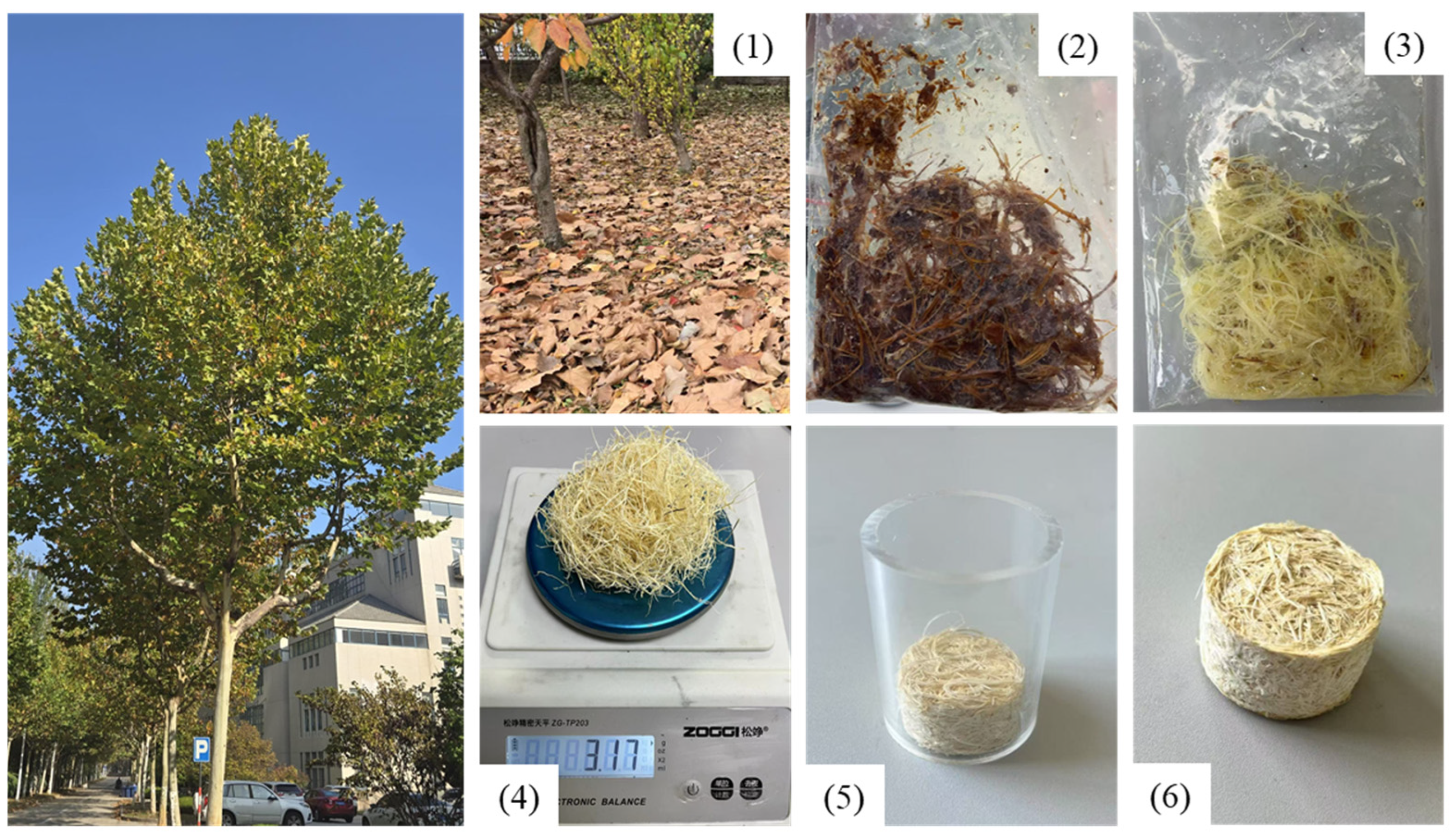
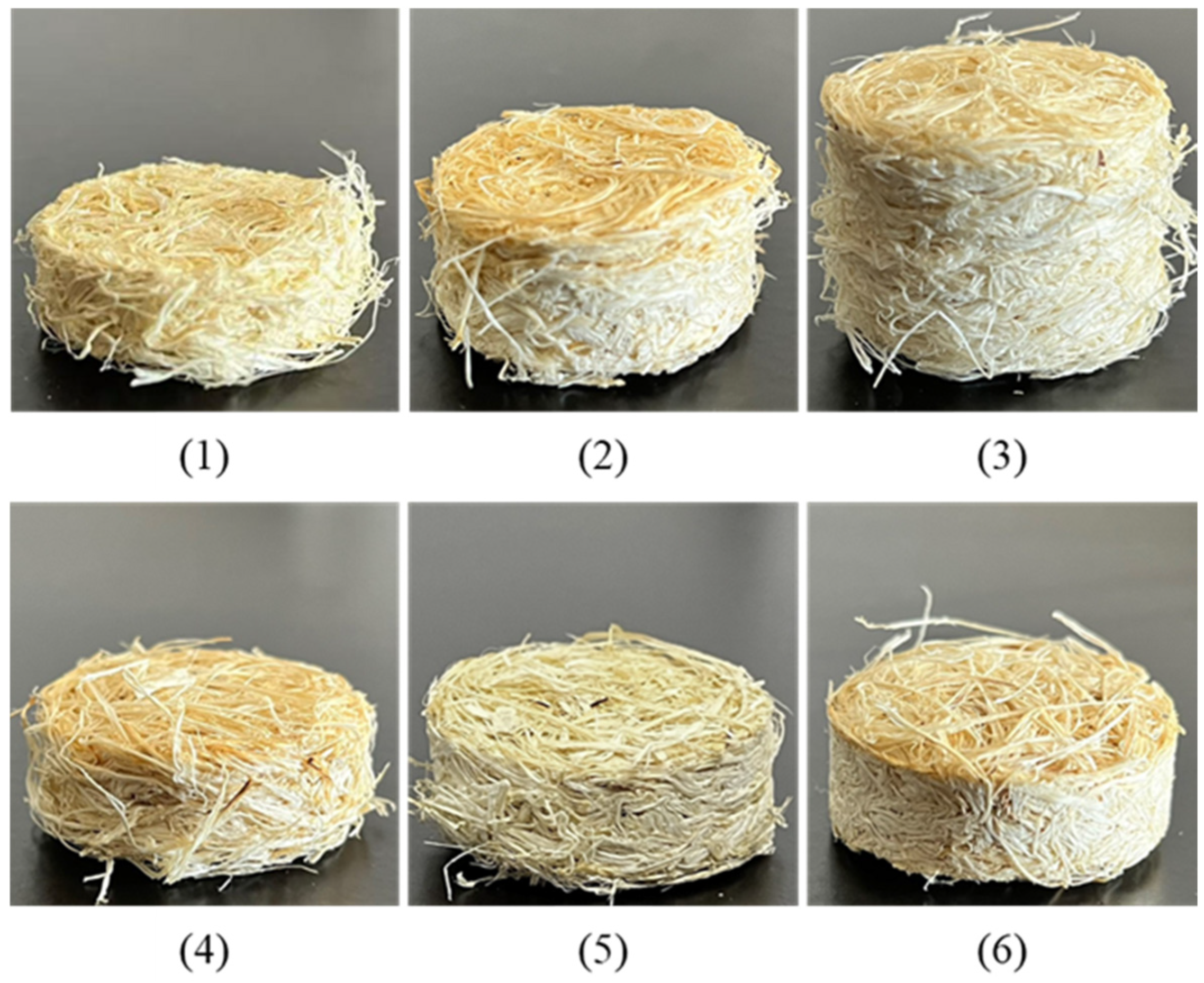
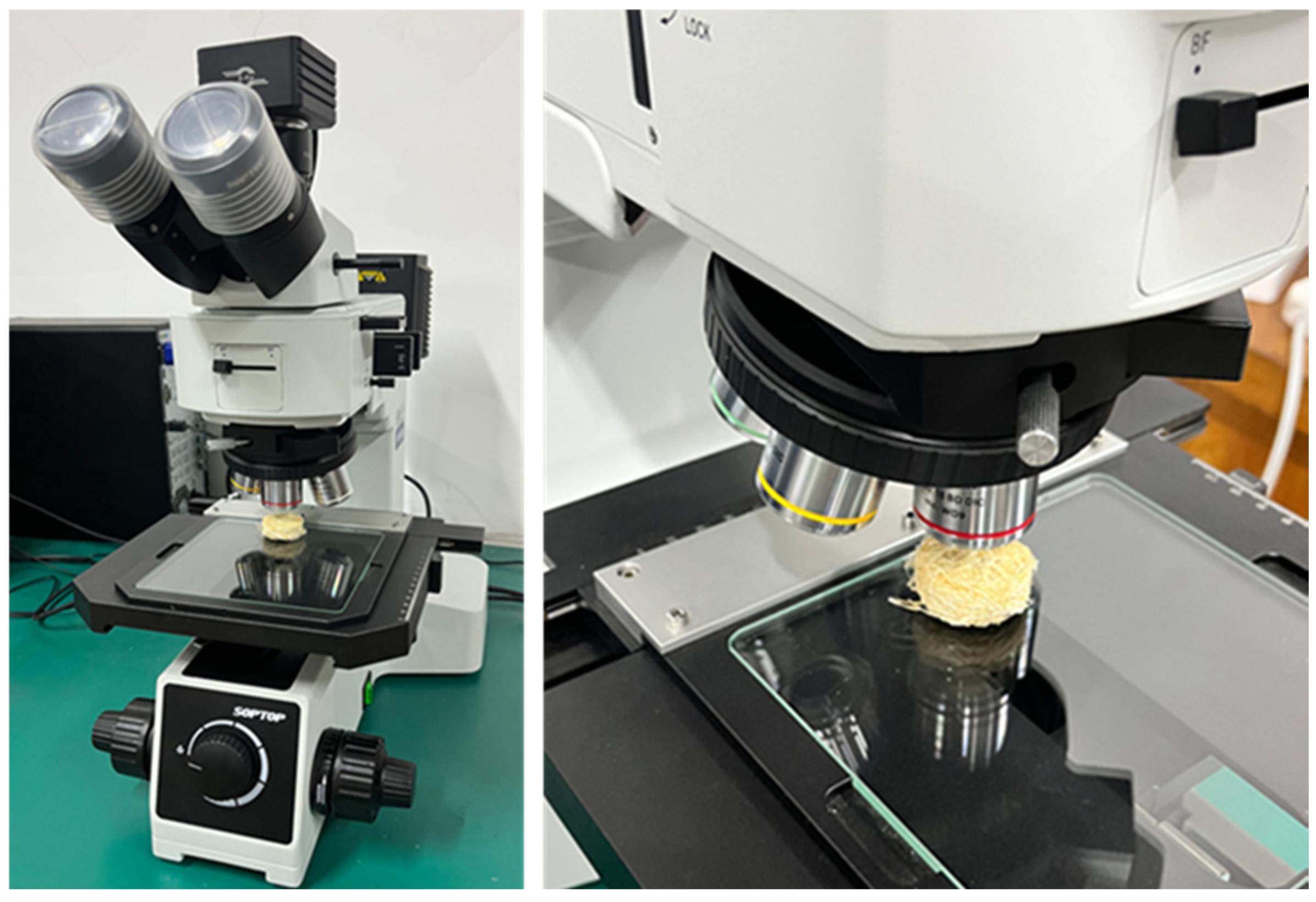


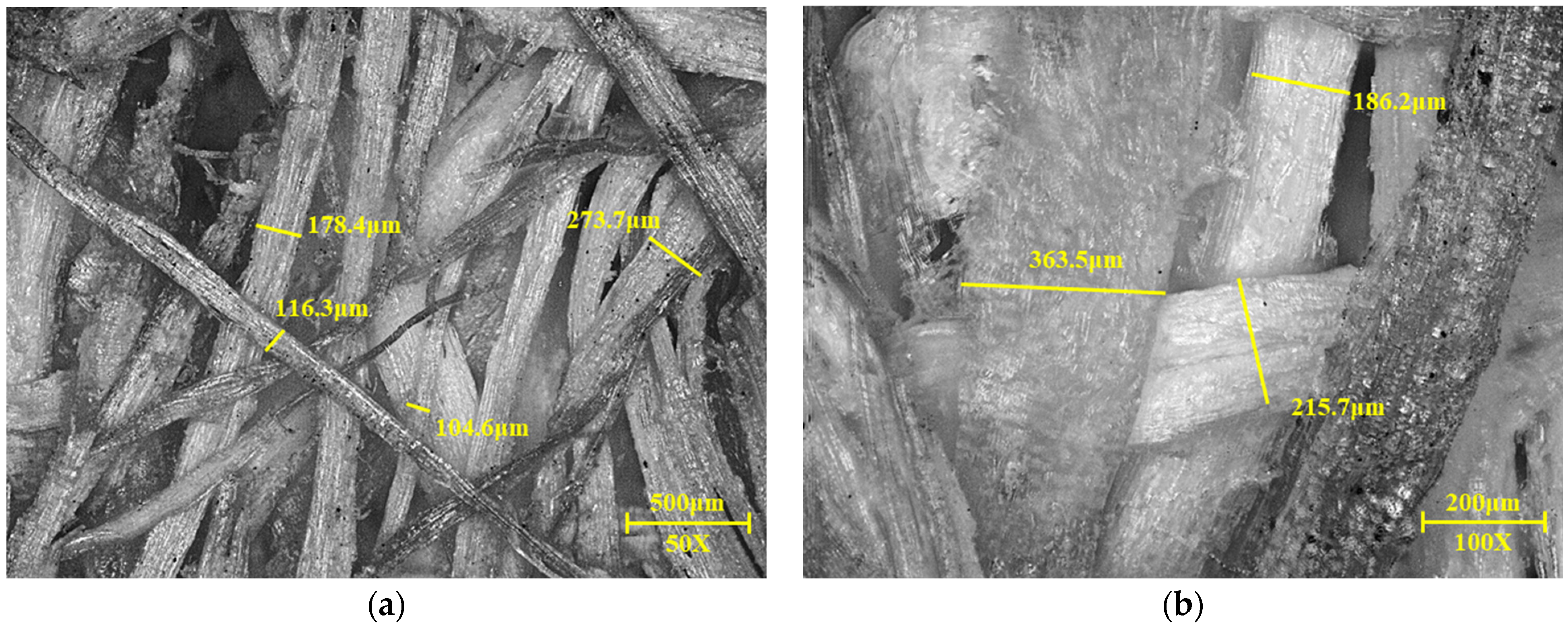
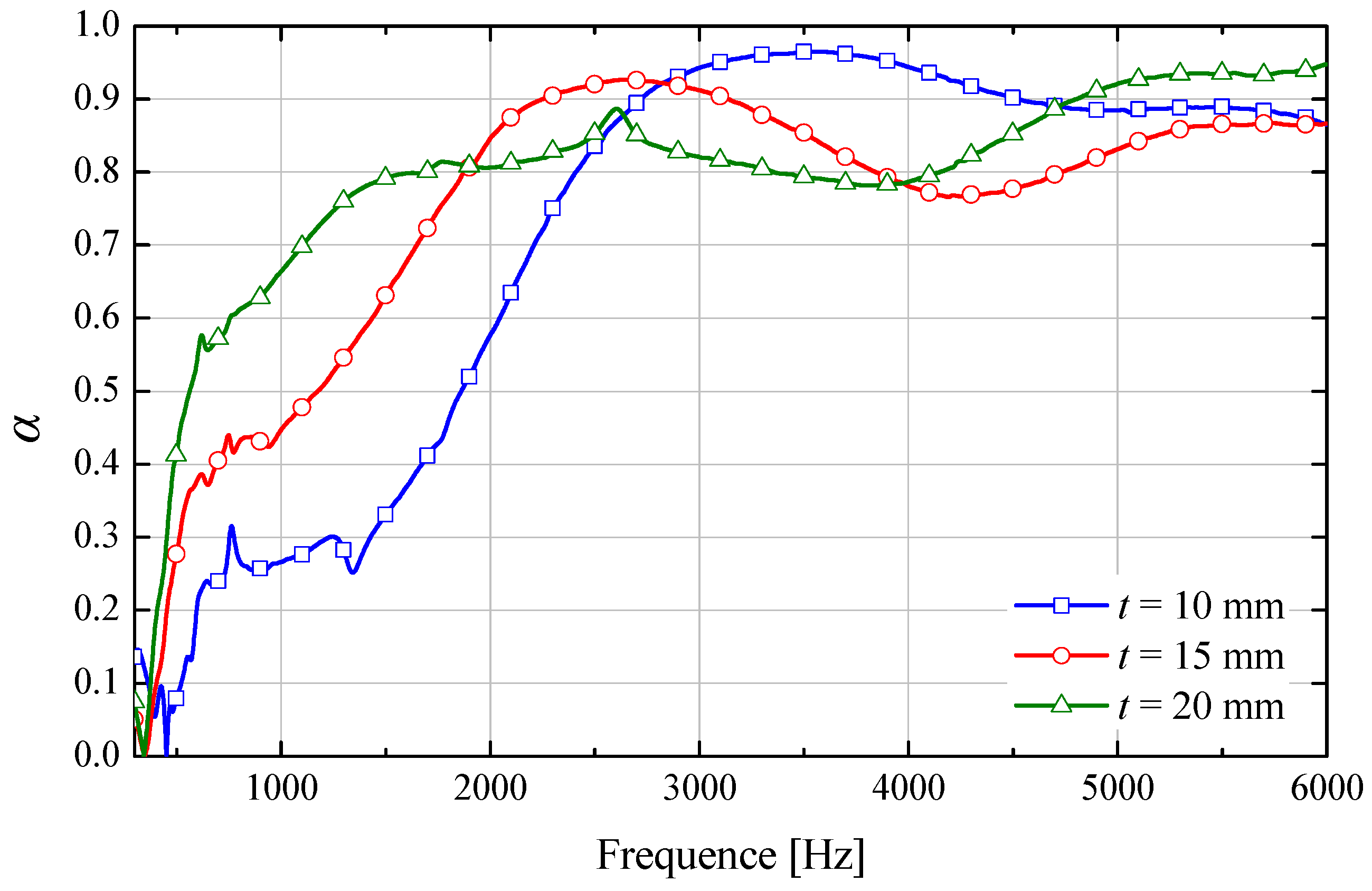
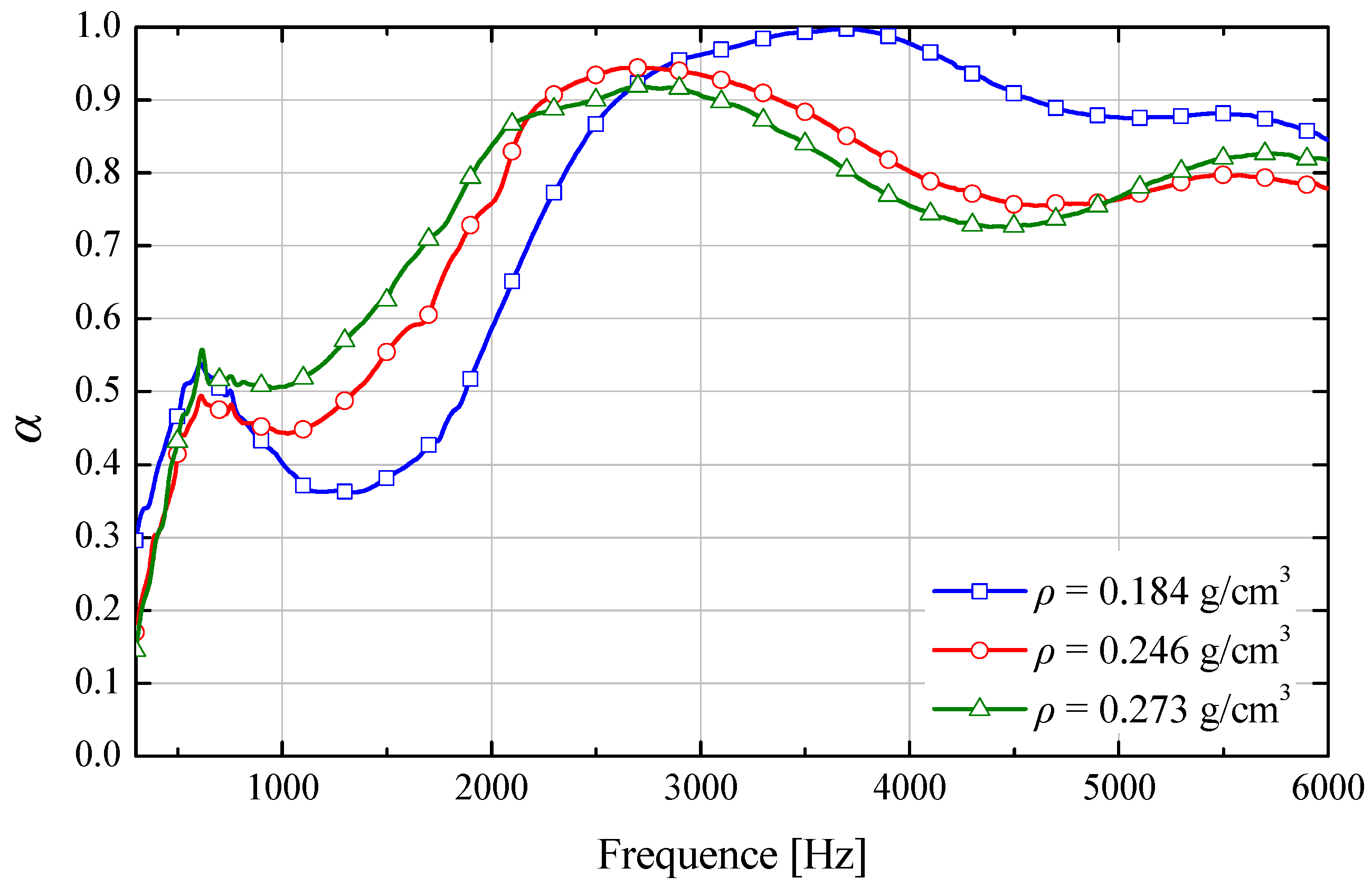

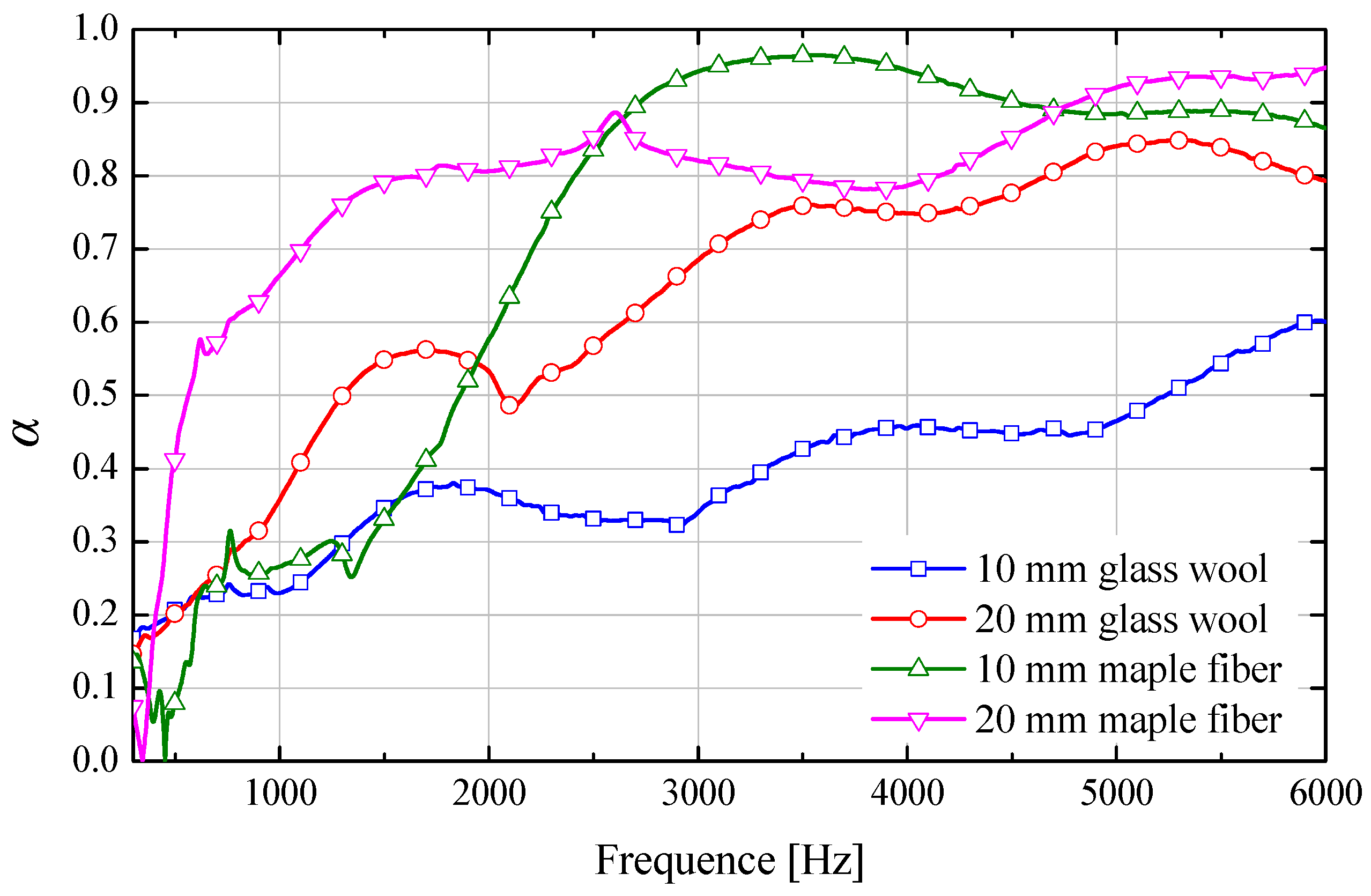
| Regions | Forest Area (Hectares) | Maple Distribution (Hectares) | Area Ratio |
|---|---|---|---|
| Northeast | 3500 | 280–700 | 8–20% |
| Southwest | 4000 | 200–600 | 5–15% |
| Central/Eastern/Southern | 5000 | 250–600 | 5–12% |
| Shandong province | 1500 | 60–150 | 4–10% |
| Sample | Thickness (m) | Mass (kg) | Bulk Density (kg/m3) | Porosity (%) |
|---|---|---|---|---|
| 1 | 0.010 | 0.00181 | 273 | 49.4 |
| 2 | 0.015 | 0.00271 | 273 | 49.4 |
| 3 | 0.020 | 0.00361 | 273 | 49.4 |
| 4 | 0.012 | 0.00146 | 184 | 65.9 |
| 5 | 0.012 | 0.00198 | 249 | 53.9 |
| 6 | 0.012 | 0.00216 | 273 | 49.4 |
| Samples | Thickness (m) | Mass (kg) | Bulk Density (kg/m3) | Porosity (%) |
|---|---|---|---|---|
| 1 | 0.010 | 0.00181 | 273 | 49.4 |
| 2 | 0.010 | 0.00007 | 10.6 | 99.6 |
| 3 | 0.020 | 0.00361 | 273 | 49.4 |
| 4 | 0.020 | 0.00014 | 10.6 | 99.6 |
Disclaimer/Publisher’s Note: The statements, opinions and data contained in all publications are solely those of the individual author(s) and contributor(s) and not of MDPI and/or the editor(s). MDPI and/or the editor(s) disclaim responsibility for any injury to people or property resulting from any ideas, methods, instructions or products referred to in the content. |
© 2025 by the authors. Licensee MDPI, Basel, Switzerland. This article is an open access article distributed under the terms and conditions of the Creative Commons Attribution (CC BY) license (https://creativecommons.org/licenses/by/4.0/).
Share and Cite
Jin, J.; Feng, Y.; Hao, H.; Cao, Y.; Zhang, Z. Potential Application of Fibers Extracted from Recycled Maple Leaf Waste in Broadband Sound Absorption. Buildings 2025, 15, 3582. https://doi.org/10.3390/buildings15193582
Jin J, Feng Y, Hao H, Cao Y, Zhang Z. Potential Application of Fibers Extracted from Recycled Maple Leaf Waste in Broadband Sound Absorption. Buildings. 2025; 15(19):3582. https://doi.org/10.3390/buildings15193582
Chicago/Turabian StyleJin, Jie, Yecheng Feng, Haipeng Hao, Yunle Cao, and Zhuqing Zhang. 2025. "Potential Application of Fibers Extracted from Recycled Maple Leaf Waste in Broadband Sound Absorption" Buildings 15, no. 19: 3582. https://doi.org/10.3390/buildings15193582
APA StyleJin, J., Feng, Y., Hao, H., Cao, Y., & Zhang, Z. (2025). Potential Application of Fibers Extracted from Recycled Maple Leaf Waste in Broadband Sound Absorption. Buildings, 15(19), 3582. https://doi.org/10.3390/buildings15193582






